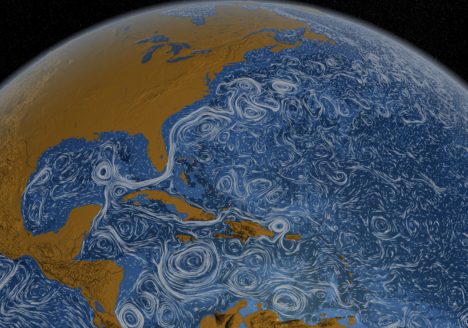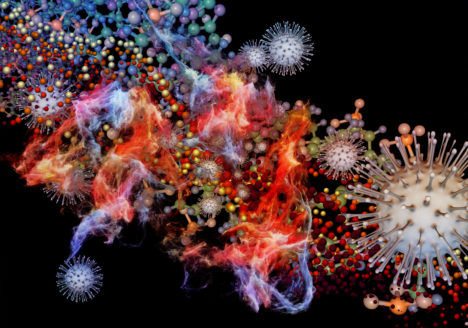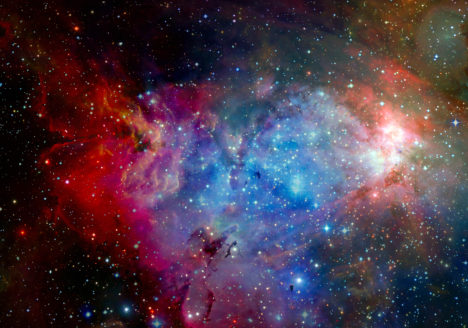Future pharmaceutical drugs and improved photo-voltaic cells may not be found through trial-and-error experiments anymore. Scientists at NBI design molecular systems on their computers, paving the way for a new type of chemistry.
Why is gold yellow? Since gold is a metal, and other metals are greyish or silverish this is actually strange. The explanation lies in quantum theory and therefore was beyond our reach, until Niels Bohr and his fellow quantum pioneers opened the door to the understanding of nature at the atomic level a little more than 100 years ago.
Needless to say, gold is highly valuable in itself. Not just in jewelry. We talk about golden periods in painting and literature, award the best athletes with gold medals, and even today governments maintain national reserves of gold. Would all this be the same, if gold had the same color as, for example, iron? Certainly not. However, the explanation behind the phenomenon goes beyond the significance of gold itself. We have entered a new age, where the development of new materials is no longer a matter of mixing different substances to see what will happen. Merging chemistry with quantum theory, it will be possible to design new molecules on a computer.
Importantly, these new molecules may have just the right optical, conductive, or magnetic properties, for example to turn sunlight into energy or storing energy long-term, for designing new drugs, or for use in the nano-size electronics that drive modern society.
“By merging chemistry with quantum theory, it will be possible to design new molecules on a computer.“
Fast electrons make gold yellow
Before going into the new field of digital chemistry, let us hear why gold is yellow. According to Albert Einstein’s theory of relativity, the properties of two identical objects will be different if they travel at different speeds. Despite general acceptance of the theory, for many years it was not considered relevant in chemistry. The other forces governing chemical reactions were assumed to be so dominant that relativistic effects could be neglected. Much later, beginning in the 1970’ies, it dawned on some physicists that the electrons in many atoms – especially the heavier elements – were actually travelling so fast that relativistic effects had to be taken into account.
An example in support of this claim is indeed the color of gold. As described in quantum theory, electrons do not orbit the atomic nucleus randomly, but follow certain orbitals. In gold, electronic transition occurs in two orbitals – from the 5d orbital to the 6s orbital. Relativistic effects increase the 5d orbital’s distance from the atom nucleus and decrease the 6s orbital’s distance. The transition causes absorption of electromagnetic radiation at the wavelengths which appear blue to the human eye. Since yellow is complementary to blue, light with a lack of blue is perceived as yellow.
Daunting costs of computation
So, how can we take quantum effects into account in chemistry? It certainly makes things harder, that quantum mechanics rarely assign specific positions and properties to specific particles. Instead, quantum theory operates with sets of probabilities for a particle being in a given position and having certain properties. This makes matters so complex, that only a few trivial systems can be solved exactly: even a single atom with more than one electron has evaded exact solution. For anything but the simplest quantum systems, we instead numerically approximate solutions through enormous calculations.
Such computational experiments provide answers to many physics and chemistry questions. However, they are typically run at supercomputers, sometimes for many months. Thus, discovery is limited by the cost of computations, which grows at breakneck exponential rates with the number of electrons.
The eScience group at NBI designs new computational methods to tackle the daunting costs of studying quantum systems: to make computational experiments feasible without supercomputers, and more powerful with them. For example, the researchers use hyper-spherical harmonics to describe the high-dimensional geometry of quantum particle interaction to model small highly interacting systems, and a geometrical understanding of low-dimensional carbon structures to model large systems. This is a form of molecular origami that hopefully will make it possible to design new molecules with desirable properties in the future.
For more information click the button below.
Other Digital Worlds developed at NBI
I FEEL I CAN BRING SOMETHING TO THE TABLE
Age matters little as the NBI researchers create digital versions of the physical world. Often it will be the students who are able to teach their experienced professors a trick or two.
Academia has always had a tradition for open exchange of ideas, including between faculty and students. In a field where being born digital is a definite plus it can sometimes even be hard to tell who is teaching whom.
“One thing I did bring to the table was a new approach to testing various hypotheses against each other,” says Dion Häfner, PhD student in the ocean dynamics group at NBI.
The group creates digital twins of oceans (as explained in the Digital Oceans chapter), mimicking currents and other processes of the real oceans.
“Creating these digital twins is really challenging and interesting. However, what interests me even more is how we can put these models into work once we have them,” says Dion Häfner.
The computer does the boring work
Digital versions of the ocean can be utilized to obtain new knowledge by manipulating certain factors. What will for instance happen if the temperature increases or if a given current is weakened?
“The thing is, when we do this type of experiments and observe some results, different people will have different stories on what is going on in our complex climate system. Previously, people would just agree to disagree, but I don’t think we should settle for that. That’s why I am developing machine learning-based tools to test different hypotheses against each other in a principled, quantitative manner. This was a new approach to the group,” explains Dion Häfner.

Asked what attracted him to the field, he replies:
“Right from the outset I liked the idea that I am able to leave a lot of the boring work to the computer. Just pushing a button and waiting for results to come in is really satisfying. Meanwhile, I can focus on what I find interesting.”
A deep connection with nature
“Running an ocean model can almost feel like playing a computer game,” Dion says with a smile, then adding on a serious note:
“But of course, this is not a game. What we create in our computers reflects what takes place in the outside world every day. As humankind we are only able to spend a limited time on this planet. If we want to expand that time, we really need to understand the world around us.”
Sounds like you are motivated by mitigating climate change?
“In part, yes. Climate change is the most urgent challenge to us right now, but I am not only focused on that. Other changes in the Earth’s climate will come after this one, and we need to understand our planet to handle them. Actually, I would say that the study of nature itself is my main motivation. Also, I am really fascinated by the technical details behind being able to build something as complex as our world inside a computer.”
The computer is not the only way for Dion to study nature, he adds:
“I feel a deep connection with nature – as most natural scientists do. Ironically though, considering that technically I am an oceanographer, I am not much of a boat person. I would probably just get sea-sick.”
“As humankind we are only able to spend a limited time on this planet. If we want to expand that time, we really need to understand the world around us.”
Dion Häfner, PhD student in TeamOcean at NBI.




